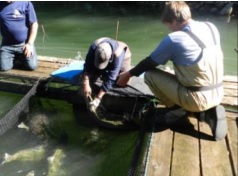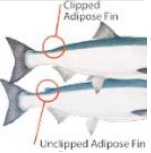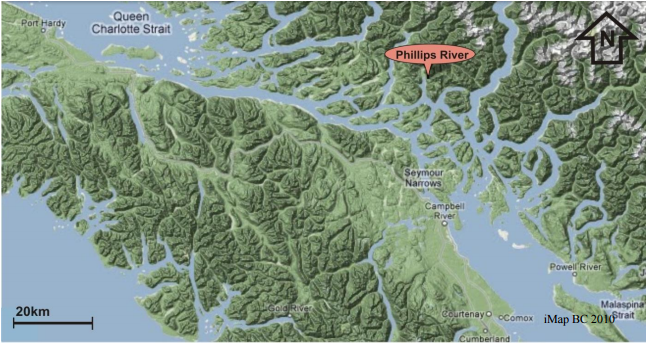
Rupert Gale checking up on chinooks that will have eggs and sperm collected to carry out a hatchery program. (GPFA 2014)
Gillard Pass Fisheries Association (GPFA) is trying to fix this problem in the Phillips River through a unique program called the Phillips S1 Chinook Trial and believe that it may be the solution for other struggling chinook populations. Where typical hatchery programs grow chinook for three months, the S1 program grows them for a full year in freshwater with help from the Omega Pacific Hatchery. It is thought that by releasing the chinook after a year, they are more capable of finding food sources, avoiding predation and disease, and are more resilient to changing ocean conditions than younger ones. GPFA’s goal is to recover the Phillips River chinook population to a healthy and self-sustaining level with the S1 program.

A clipped adipose fin is one way GPFA determines a fish is of hatchery origin compared to a wild fish with an adipose fin. It is important to be able to distinguish between wild and hatchery fish to obtain useful data. (GPFA 2014)
The eggs and sperm are first collected from chinooks at the Phillips River before they are transferred to the Omega Pacific Hatchery to be fertilized, incubated and reared. During this process, the approximately 40,000-50,000 juvenile salmon are fed slowly in an attempt to mimic wild conditions. At the end of the year, Rupert Gale (President of GPFA) and Carol Schmitt (President of Omega Pacific Hatchery) transport half of the fish to the head of the Phillips River’s arm to be held for a week in sea-pens while the other half are moved to net-pens in Phillips Lake. This allows for the chinook yearlings to remember where they are released and makes sure that they will return to the Phillips River to reproduce. Coded wire tags (CWT), which allow the fish to be traced back to a specific group, are attached to all fish from the S1 program so they are identifiable when caught by fisheries or by those conducting studies of the GPFA Phillips River S1 program. The adipose fin of S1 fish is also clipped as an external marker that allows them to be easily identified. The identification of the chinooks allows the GPFA to collect data on the fish to examine the success of the program.
Click here to see the 2011 release of S1 smolts in Action.
Click here to see what the results of the S1 program so far.
